Text
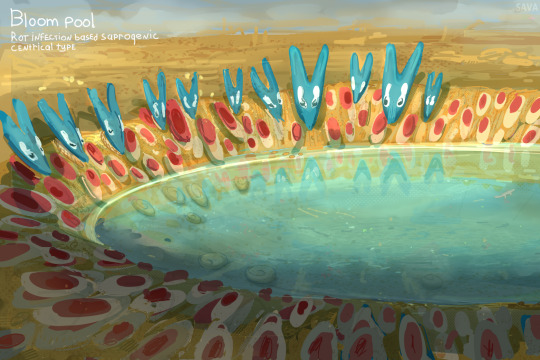
Sinedenian Bloom Pools
Rot Rings or Bloom Pools are common temporary microecosystems on Sinedey that can be found throughout foam grass biomes. They form due to the sudden mass death of a specific spot on the mat of foam grass, which can occur for a number of different reasons, such as rot, infection, fire, lightning strike, aggressive grazing by animals. Such scars on the mass of grass heal at a slower rate, since the fight of the grass mat against necrosis can drag on for up to several months. This allows water to accumulate in the crater formed, giving rise to isolated communities of organisms.
Here is a saprogenic centric type formed by a rot infection. In rot rings filled with water, colonies of moisture-loving parasitic heliophytes of all colors and shapes quickly appear, as well as small populations of aquatic plants and creatures that feed on dead tissues of foamy grass. Such organisms are adapted to life in highly acidic water.
This is just one type of rotten rings; there are also larger rotten rings of various shapes and depths, unfilled with water, with unique communities of organisms, different levels of water acidity, or with a longer period of existence. This interesting phenomenon of the planet has particularly attracted the interest of many ecologists, researchers who even “hunt” for them in search of new unique types.
82 notes
·
View notes
Text
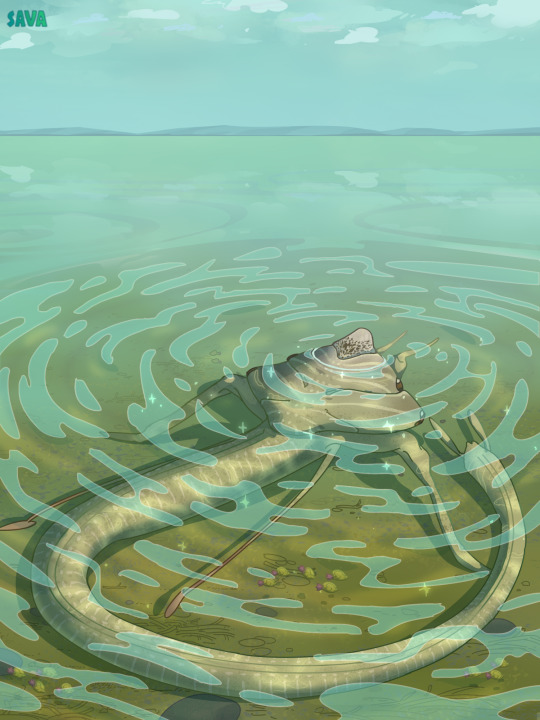
An art piece ive made for the Isla project episode that you can watch on youtube!
370 notes
·
View notes
Text
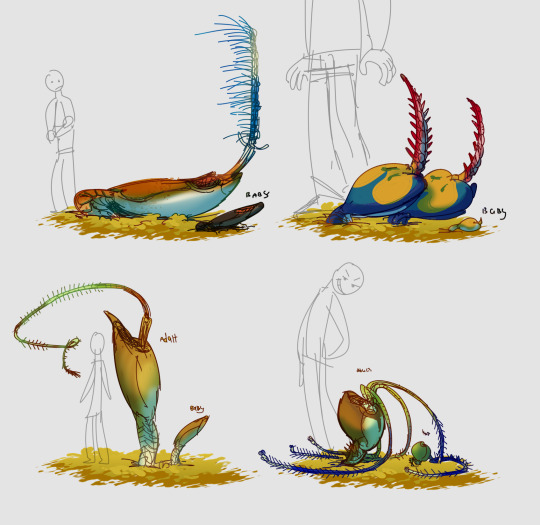
Slankats
Slankats are a wide group of Sinedenian parasitic heliophytes, most often found in areas with particularly thick foam grass layers which they parasitize on. It is the main host for the most slankats, although there are some exceptions.
This group of mixotrophs especially stands out from the rest, having a more animal-like appearance rather than the usual plant-like body plan. Some might confuse them with barnacles, due to their segmented tail and valved body with a feathery appendage.
They are highly specialized for parasitic lifestyle, to the point that some of them cannot produce their own nutrients by photosynthesis at all.
General anatomy of slankats
Their large bodies, despite their visual bulk, are actually very light and contain only a small number of tubular organs as well as a cavity for folding the stem into it. They attach to their hosts with the help of a scaly tail, at the end of which there is a spiked anchor with the bases of root organs on the sides. The roots of slankats are thin, long and highly branched, which allows them to absorb as many nutrients as possible from the foam grass.
At the top of the body there is a gill plate, with the help of which slankats breathe. Next to it there is a hole, from which emerges a flexible stem with genital organs growing on it (whip-flowers and chains of fruits).
The number of whips differs for different types of slankats (from 1 to 10). These whips carry female and male reproductive cells and unction similar to flowers on earth. When the whips are pollinated, after some time they wither away and in their place the fruits begin to grow, the number of which also varies. They can grow either in a chain or in a kind of bouquet.
Slancat fruits carry from two to ten embryos, and the fruit also contains chambers of gas that allow the fruit to fly away on wind currents or float on the surface of the water during floods (depending on the species, breeding cycle and season). When the fruit gets carried away to a fitting place, embryos emerge by popping out of the husk of the froot and then borrow into their host by using their tails.
152 notes
·
View notes
Text

Deep in the dead forest
#missionsinedey#creature design#worldbuilding#speculative evolution#oc#original character#spec evo#biology
17 notes
·
View notes
Text

Oh Laios thats not...
#delicious in dungeon#dungeon meshi#berserk#beherit#marcille dungeon meshi#senshi dungeon meshi#laios dungeon meshi#chilchuck
133 notes
·
View notes
Text
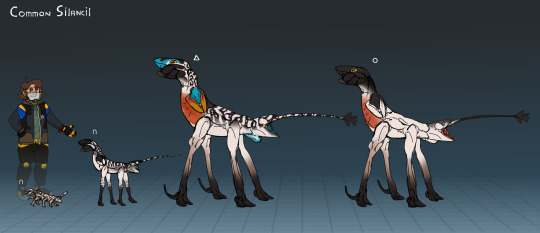
Common Silancil
These graceful animals are a rare sight in deep ancient paraforests of Sinedey, more common in colder regions of the planet. They are omnivorous creatures mostly feeding on molds, tree bark and various parasitic plants, rarely snacking on small prey.
They are known for a striking sexual demorphism with bright and striped males. both sexes have foldable wings for showing off to their partners and scaring predators away, but males poses way more intricate and colorful patterns on theirs.
Next to a male and a female on the right, two juvenile stages on the left are shown, newly hatched babies have different anatomy, that helps them to hide in the forestfloor, burrowing under dead plants. More older juveniles are looking way more like their parents, but posesing stripped coloration to blend in the forest.

Simplified anatomy of male and female. (its a bit old and needs some fixes so idk, critiques are still welcome)
1. eyes 2. brain plate 3. throat 4. esophagus 5. an organ containing both ears and larynxes connected to the first set of lungs 6. harmone producing organ 7. stomach 8. filtering organs (similar to kidneys and liver) 9. intestines 10. heart 11. cloaca (but genitals are separate) 12. testies 13. second set of lungs 14. male genitals 15. flexible hooked end of male genitals 16. scent gland on the end of the abdomen 17. ovaries 18. ovipositor
48 notes
·
View notes
Text
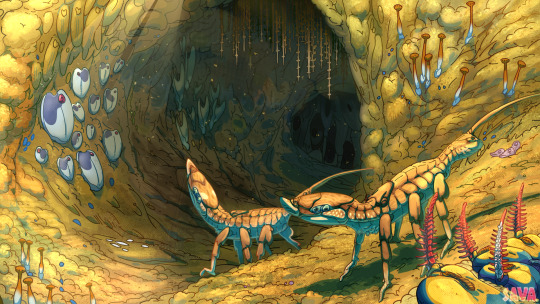
Sinedenian organic cave
Descending a steep slope, a pair of Skritniks stumble upon an open plant cave in the upper layers of foam grass. A musty, slightly sweet, putrid-smelling air slowly emanates from inside the cave, attracting their attention. These omnivorous varmints (family negadiadae) are not averse to feasting on a scattering of parasitic plants on the walls and floor of the cave; not many animals are able to digest such parasites, whose bodies are saturated with putrefactive poisons, but some especially aportunistic species, such as skritniks, are adapted to feeding on even such a desperate snack. Despite their poisons and hard shell, the bodies of paraphytes are rich in sugars and other delicacies so desired by hungry pranksters. But they still explore the area with caution before entering the cave, which may harbor dangers far greater than indigestion.
#missionsinedey#worldbuilding#original character#speculative evolution#creature design#spec evo#biology
745 notes
·
View notes
Text

Is this too much to ask for!?
82 notes
·
View notes
Text

Someone more and worse than a human
15 notes
·
View notes
Text

They are watching
15 notes
·
View notes
Text

A commission artwork i did for one person from instagram.
43 notes
·
View notes
Photo

Color wheel challenge spec evo edition!
Massive collection of creatures from different projects as a color wheel challenge i did on twitter!
This was super fun and im glad i could express my biiig love to this community in such way
121 notes
·
View notes
Photo



Open waters of the Southern ocean of Sinedey.
Giant madarna, a member of a unique branch of ratoon sea serpent family, chases a flock of small fovits near the surface of warm open waters, teeming with various heliophytes — unique, mostly aquatic, mixotrophic organisms capable of activly swimming though water column.
Here you can see three different types of heliophytes: tube-like doons. filling a niche similar to free swimming cnidarians, they slowly drift and filter feed on small organic particles from water. they are also a home to various kinds of aquatic organisms like these tiny fish on the top; small banana looking nymphs of rooster-grass, a really weird organisms ill focus on later; and tiny fast swimming rods with a hard transparent shell called kanakha, they are colonial at some point, consisting from a few individuals that form a shell that conects them with each other. they form flocks to escape predation more effectively.
The most of heliophytes use jet propulsion too like these species, tho there are other groups of these weird creatures that use other forms of locomotion which i explore later.
The second image shows the size of all represented organisms compared to a human.
In the third image, I suddenly decided to explain the anatomy of the respiratory / jet propulsion of sea serpents using madarna as an example.
58 notes
·
View notes
Photo

Sanjay encouters a friendly alavir in the coastal waters of the southern ocean.
These slender and long sea serpents are top predators of the many southern aquatic ecosystems. They are curious and smart creatures that are known for their playful behaviour.
83 notes
·
View notes
Photo
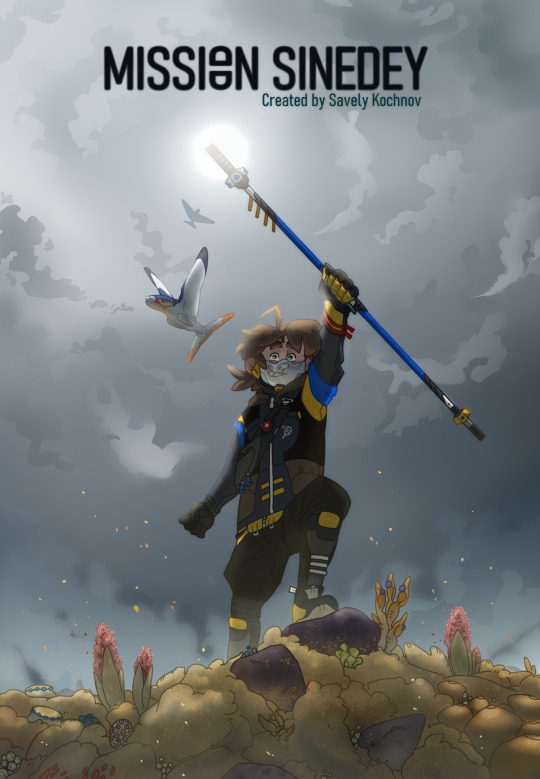
A poster for the project showcasing the main character Sanjay and his alien bird companion Tavik. I’m just fantasizing about making a Mission Sinedey comic someday ig
27 notes
·
View notes
Photo

First time posting here, here’s an artwork from my personal worldbulding project “Mission Sinedey”
A scene of Sinedenian plains depicting a Blitzkrieg stealing an unnamed negodiada baby from its unfortunate parents.
200 notes
·
View notes